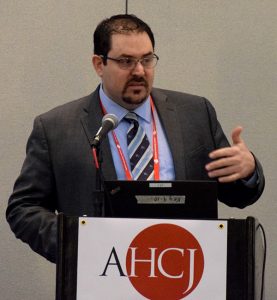
As journalists, we focus on the increasingly common phenomenon of mass shootings. They are appalling, they are terrifying and we don’t fully understand them.
But gun violence is far more common, far more widespread, and far more insidious than those high-profile events – both murder and suicide. And we aren’t doing enough to think about and address firearms deaths as a public health problem, rather than a law enforcement problem, panelists told a Health Journalism 2019 panel in Baltimore on Friday.
Baltimore Sun editorial writer Andrea K. McDaniels gathered three Baltimore-based physicians and public health experts to discuss gun ownership policies, shock trauma and treatment, and the larger question of how to mitigate violence in the community.
The first speaker, Joseph V. Sakran, M.D., M.P.A., M.P.H., director, emergency general surgery at Johns Hopkins, had his own indelible introduction to gun violence when he was shot in the neck with a .38-caliber bullet at age 17. He gave an overview of some key statistics to show just how pervasive the gun violence epidemic is – and he reminded the roomful of reporters that while mass killings are news, “We have young black men who are being killed and their stories are often going untold.”
Sakran noted:
- One out of three American kids live in a home with a gun.
- 6 million kids live in a home with a gun that’s unlocked and loaded.
- And the biggest cause of gun deaths is suicide – roughly two-thirds of the firearm fatalities in any given year are suicide.
- Mass shootings, though traumatic to our society, represent 2% of the overall gun deaths.
The U.S. is doing far too little public health-oriented research into gun violence, Sakran argued. If NIH put the kind of government funding into it that it had invested in other causes of death, we might be able to come close to eradicating it in the U.S., as we did with cholera and polio. (An aside! He did not mention measles, and I couldn’t help but wonder if he might have if he gave this talk six months ago.)
Jon Vernick, a health policy professor at Johns Hopkins and the co-director of the Johns Hopkins Center for Law and the Public’s Health and associate director at its Center for Injury Research and Policy Johns Hopkins Bloomberg School of Public Health, stressed that the homicide rate for young black males is nearly 20 times higher than for the population as a whole.
But neither suicide nor the mass deaths of young black males is driving policy. (Just imagine, he said, how much policy action there’d be if white male congressmen faced such odds.)
After peaking in the early 1990s, gun violence tapered off a bit (and policies addressed it). Now it’s on the rise again. The U.S. has about 300 million guns in private (non-police, non-military) hands. Most of them are long guns, rifles and shot guns. But most of the deaths are from handguns.
Vernick also noted that people who survive a suicide attempt – typically an overdose – don’t try again. And they get help. But people who attempt suicide with a gun usually don’t’ get a second chance. They die.
Jacques Mather, M.D., M.P.H., a trauma surgeon at the University of Maryland’s R. Adams Cowley Shock Trauma Center and director of the Center for Injury Prevention and Policy, said he used to think his job was to to save gunshot victims whenever possible in his trauma unit. Now he knows it also means addressing both the causes and the aftermath of violence in the community.
He spoke about how difficult it remains, after years of doing this work, of watching a young person die from a bullet and hearing the trauma nurse say, “The family is in the waiting room.”
“You just became the face of their child’s death,” he said.
“The epidemic of gun violence touches everyone. We all have a role in fighting it.”
He’s working with several anti-violence initiatives in Baltimore, some still being evaluated, and sees some tentative bright spots. Having people in the community trained to defuse violence within their community is one strategy that has promise.
The panelists and the audience had some interesting – though inconclusive – exchanges about how reporters should cover killings and deaths by suicide. One of the panelists urged more coverage of suicide; several reporters countered that mental health experts have discouraged covering both suicides and murders for fear of spreading “mass contagion.” That tension – how to tell the stories with nuance and context in ways that reduce, not cause, harm – was not resolved.







